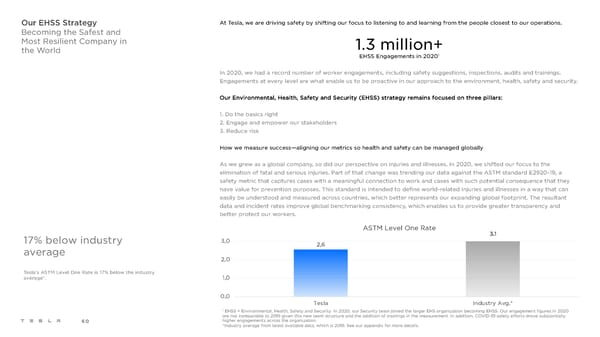Our EHSS Strategy At Tesla, we are driving safety by shifting our focus to listening to and learning from the people closest to our operations. Becoming the Safest and Most Resilient Company in 1.3 million+ the World EHSS Engagements in 20201 In 2020, we had a record number of worker engagements, including safety suggestions, inspections, audits and trainings. Engagements at every level are what enable us to be proactive in our approach to the environment, health, safety and security. Our Environmental, Health, Safety and Security (EHSS) strategy remains focused on three pillars: 1. Do the basics right 2. Engage and empower our stakeholders 3. Reduce risk How we measure success—aligning our metrics so health and safety can be managed globally As we grew as a global company, so did our perspective on injuries and illnesses. In 2020, we shifted our focus to the elimination of fatal and serious injuries. Part of that change was trending our data against the ASTM standard E2920-19, a safety metric that captures cases with a meaningful connection to work and cases with such potential consequence that they have value for prevention purposes. This standard is intended to define world-related injuries and illnesses in a way that can easily be understood and measured across countries, which better represents our expanding global footprint. The resultant data and incident rates improve global benchmarking consistency, which enables us to provide greater transparency and better protect our workers. ASTM Level One Rate 3.1 17% below industry 3,0 2,6 average 2,0 Tesla’s ASTM Level One Rate is 17% below the industry average*. 1,0 0,0 Tesla Industry Avg.* 1 EHSS = Environmental, Health, Safety and Security. In 2020, our Security team joined the larger EHS organization becoming EHSS. Our engagement figures in 2020 are not comparable to 2019 given this new team structure and the addition of trainings in the measurement. In addition, COVID-19 safety efforts drove substantially higher engagements across the organization. 60 *Industry average from latest available data, which is 2019. See our appendix for more details.
 Tesla Impact Report 2020 Page 59 Page 61
Tesla Impact Report 2020 Page 59 Page 61